Among the works that art-historical research has linked to the name of Lorenzo di Credi (autographs, school and workshop works, attributions), many are lost or unidentified: therefore, when some come to light again, it is appropriate to propose them for the attention of critics. Such is the case with the tondo with anAdoration of the Child mentioned in the Crowe-Cavalcaselle History when it was in the Barker1 collection in London, but of which traces seemed to have been lost after the sale of the collection itself (1874). In reality the work passed repeatedly through the market, and transited through English and American collections; today, after careful restoration, it has been brought to my attention by the antiquarian Robert Simon of New York, to whom I owe a series of good photographic reproductions and a card that punctually documents the work’s fortunes2.
The panel measures little more than 90 centimeters in diameter, and already this fact is positive, since the tondi belonging to Lorenzo di Credi’s early activity are of similar size; but in any case the reference to the painter is entirely easy, since the composition, which is very simple, corresponds to a scheme that the artist developed several times in the late 1970s and during the following decade, taking it up again later: the characters, placed outdoors, are the Madonna (a mother-child in the youthful solutions) kneeling and praying, and her newborn son lying in the foreground, leaning on a bulging sack or a bundle of ears of corn, one finger grazing his mouth; in most cases, a small St. John, also praying, leans solicitously over the Child; in the background is a lake landscape, where rocks, hills, trees, and, in the far planes, variously articulated architecture are associated, with a few features evoking transalpine types. Representative of the formula described here are above all the tondi from Berlin, Karlsruhe, Venice, and the one already in the Casati collection, the most qualitative and perhaps the oldest, to which I have devoted particular attention in the past; all are circumstantially referable to the decade 1475-1485 (and the date 1485-1490 also agrees with the tondo we are discussing), but the formula will still be valid for some solutions belonging to the late activity, where, moreover, a more mature typology is adopted for the Virgin3.
 |
| Lorenzo di Credi, Adoration of the Child (panel; New York, private collection) |
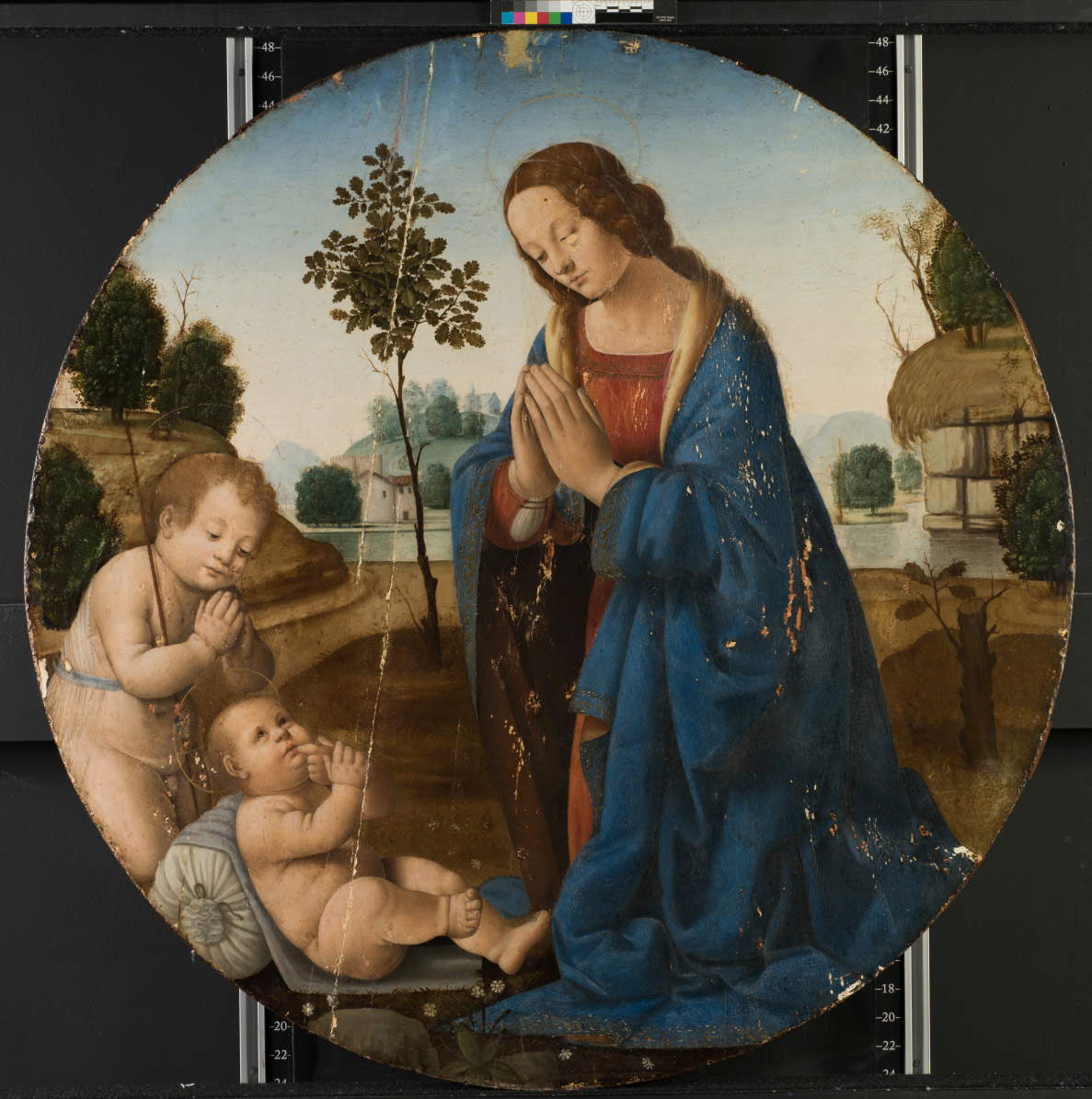 |
| Lorenzo di Credi, Adoration of the Child, state of conservation of the work before restoration |
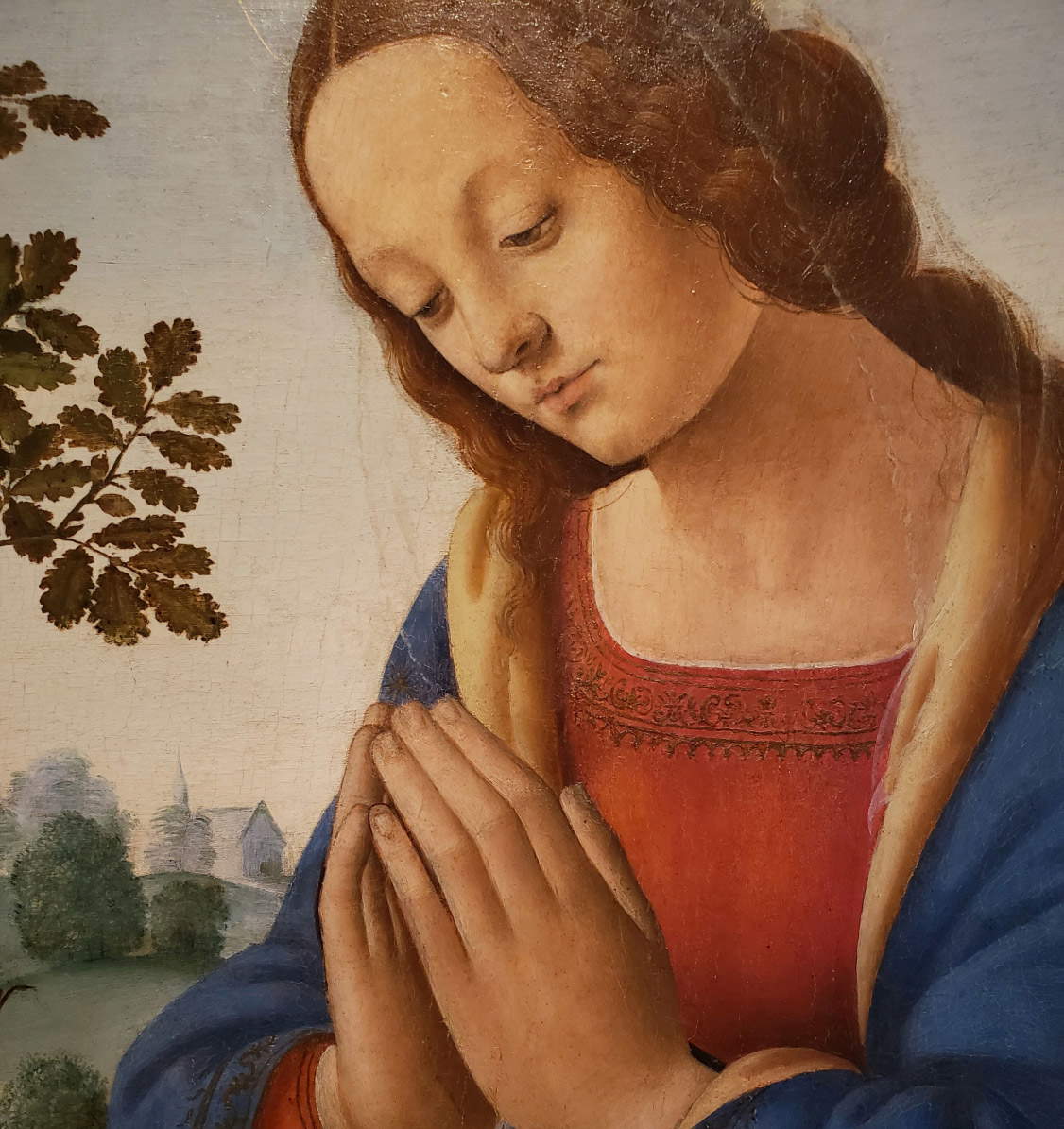 |
| Lorenzo di Credi, Adoration of the Child, detail of the Virgin |
 |
| Lorenzo di Credi, Adoration of the Child, detail of the little Saint John |
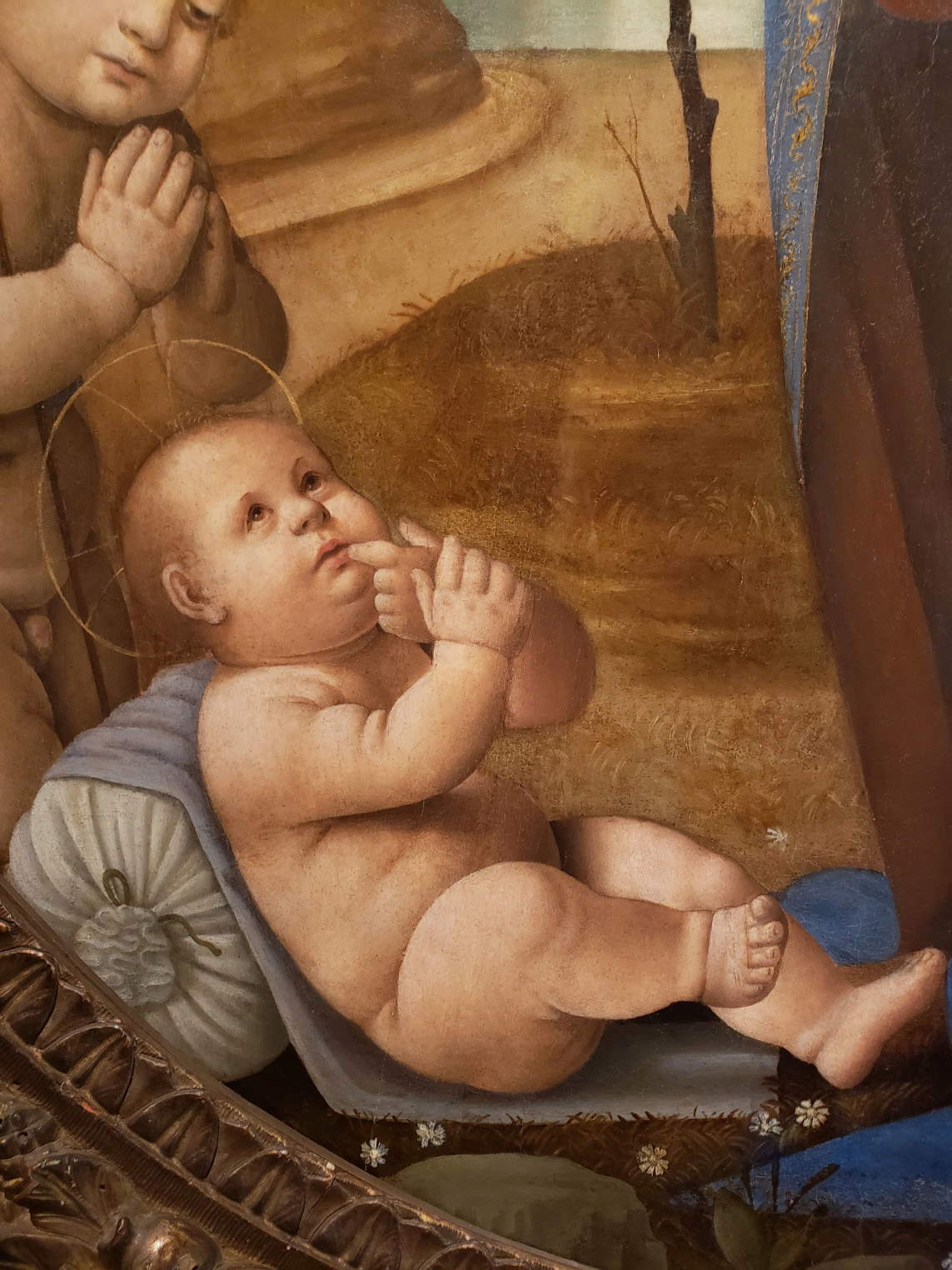 |
| Lorenzo di Credi, Adoration of the Child, detail of the Child |
In the youthful Adorations and Madonnas, a small backdrop often appears, that is, a screen that serves as a counterground for the figure of the Virgin, but this is not the case in the tondo now in New York, where it was necessary to leave room for a specific component of which I will say more in a moment. In the present case, the experimented scheme is clearly articulated: on the left, a grassy hump surrounded at its base by an uphill road (see the former Casati tondo), on which a flock and a shepherd appear, alluding to the Good News; in the center, the vision sinks toward the body of water following slight undulations of the terrain covered by disciplined vegetation, then, on the right, another rocky outcrop signals, for the viewer, the conclusion of the ’reading path. The architectural elements inserted in the background (a small church, two small houses leaning against two towers) seem to belong to a barely sketched drafting, as does the turf, which is devoid of detail if one compares it with the dense plots of grasses and flowers that appear in other works by the artist, such as the Querini Stampalia (Venice) tondo or theAdoration of the Magi in the Uffizi executed for Jacopo Bongianni4. Moreover, the New York tondo does not show the characters proper to some of Credi’s pupils, such as the alleged Cianfanini or Giovannantonio Sogliani, and does not reveal explicit traces of collaboration: I believe that it was set up and painted for a large part by Lorenzo, to whom we owe both the basic drawing and the execution of the characters; perhaps the need to deliver the painting urgently forced the master to shorten the time of execution, leaving the pose plan and the background roughly defined; but perhaps there is another explanation, which I will come to in the conclusion. The master’s peculiar skill is manifested in the broad plan, the harmonious connection between the parts, and the measured coloring registered in the figures in the foreground, the two Children and the Virgin: above all, the modeling and the textural density of the drapery that characterizes the Virgin’s blue mantle testify to the direct intervention of Credi, whom we see often confronted with the glazed splendor of Della Robbia majolica.
In his description of Lorenzo’s technique, Vasari5 appreciates the smoothness and impeccable finesse of the surfaces, but he does not hide a certain impatience with the painter’s slowness and fussiness, and with his specialism: I recall that Lorenzo worked only as a draughtsman and as a painter on panel, preferring the small size. But it goes without saying that Vasari felt far from a kind of medietas crediana, that is, from an orientation that tended to choose moderation and sobriety over complication and excess. It is no coincidence that he chooses to decorate the Virgin’s room with small bouquets of flowers tucked into a rustically manufactured glass, discarding elaborate containers: the only vase of any value executed by Lorenzo(Madonna of Mainz), evokes, but does not imitate, Leonardo’s splendid carafe(Madonnadelgarofano, Munich), sophisticated in form but also in the choice of flowers that make up the bouquet.
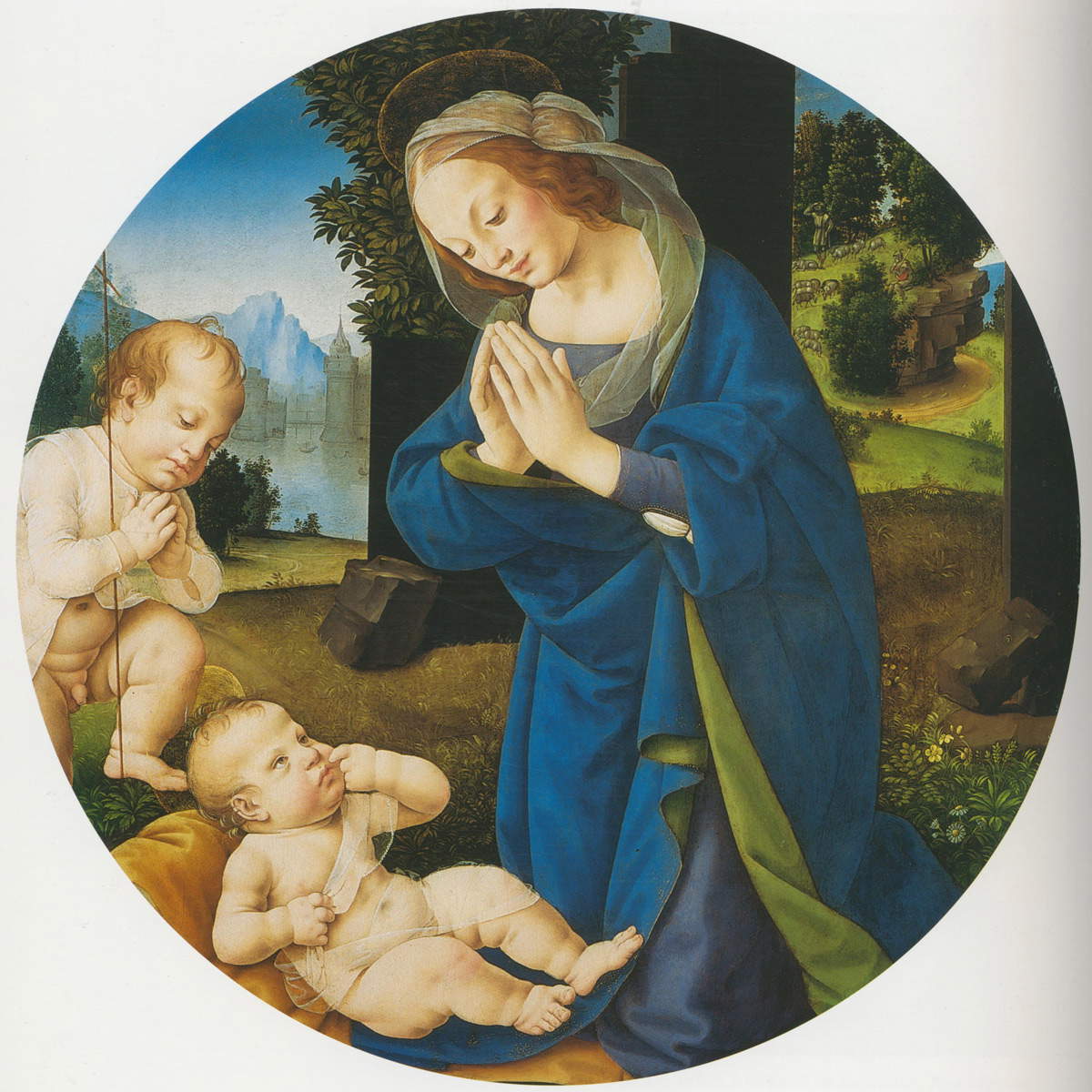 |
| Lorenzo di Credi, Adoration of the Child (panel; private collection, formerly in Casati Collection) |
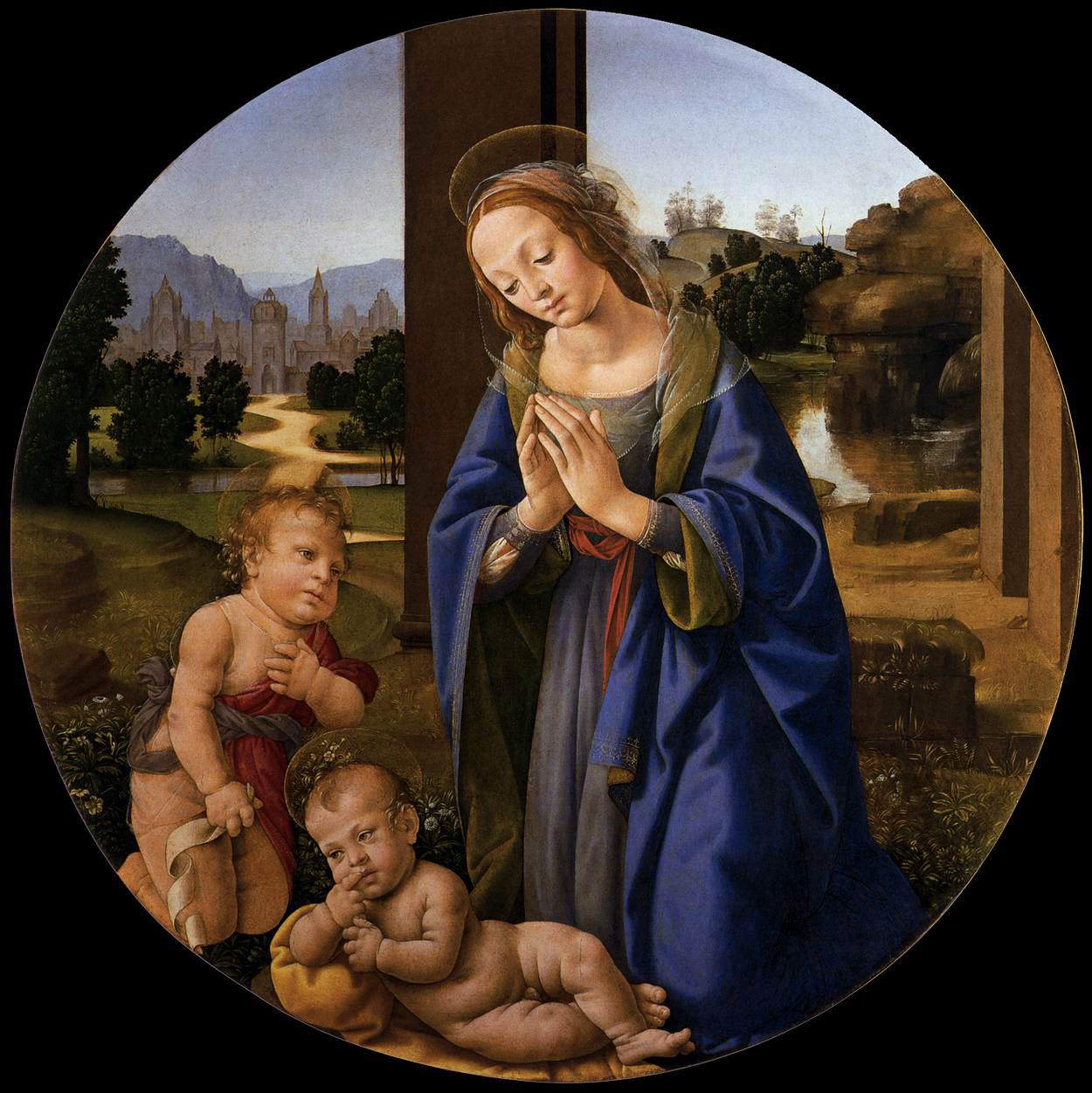 |
| Lorenzo di Credi, Adoration of the Child (panel, diameter 97 cm; Venice, Fondazione Querini Stampalia) |
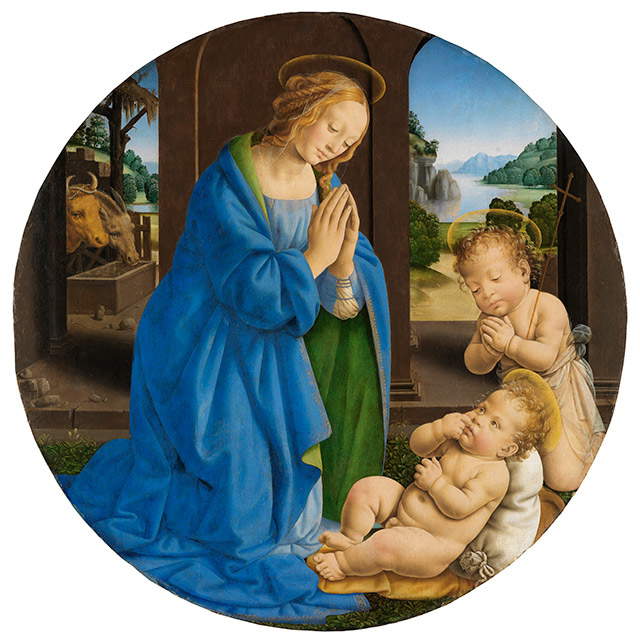 |
| Lorenzo di Credi, Adoration of the Child (panel; Karlsruhe, Kunsthalle) |
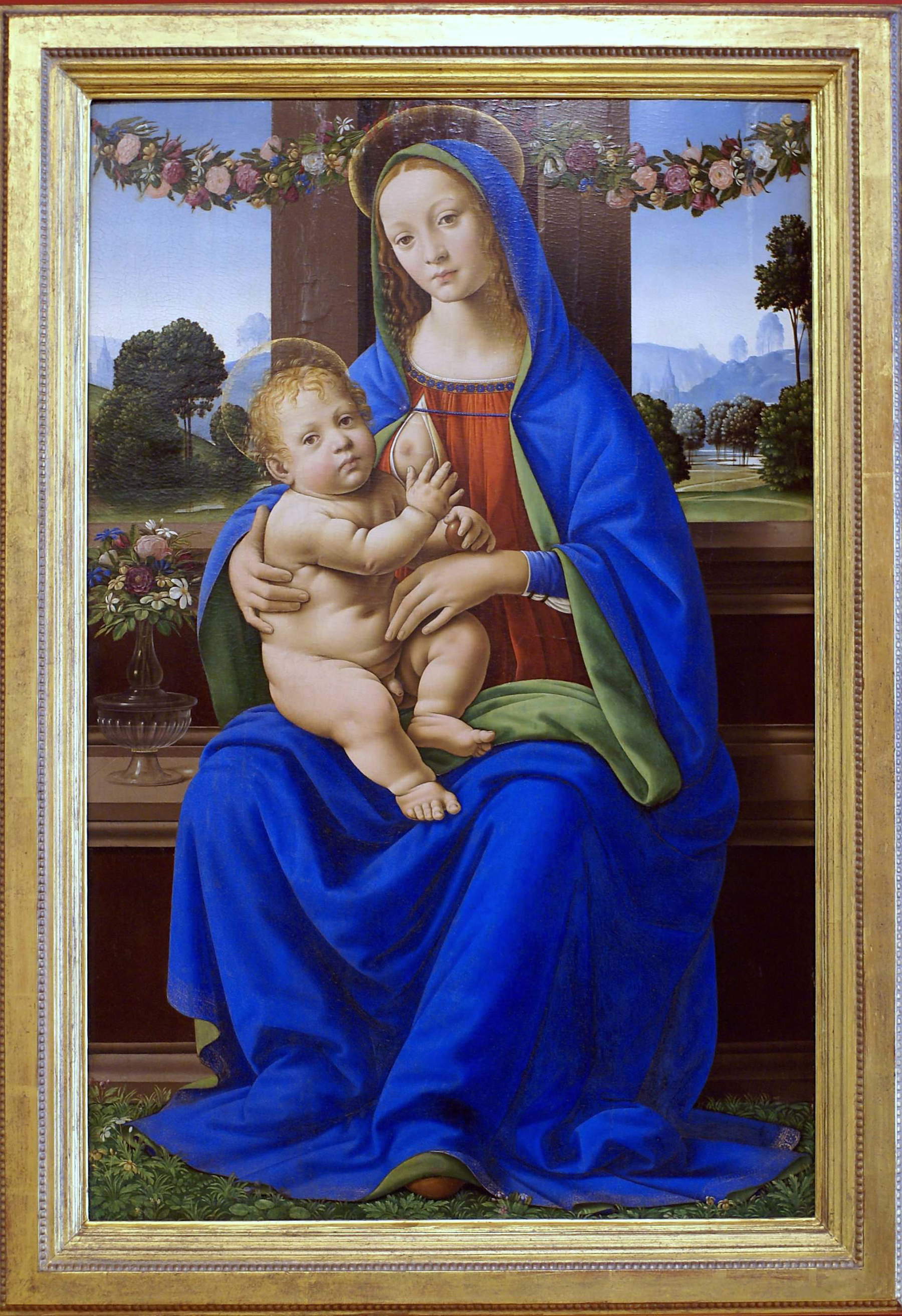 |
| Lorenzo di Credi, Madonna and Child (panel, 88 x 58 cm; Mainz, Landesmuseum Mainz) |
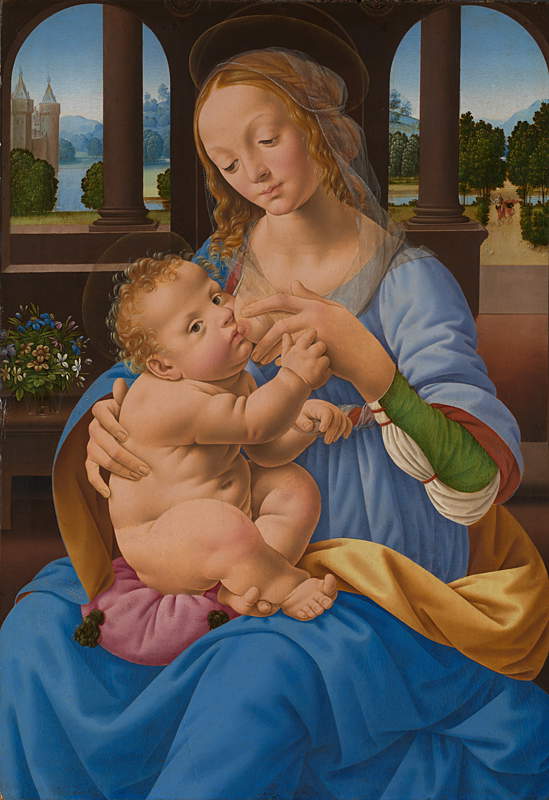 |
| Lorenzo di Credi, Madonna and Child (oil on panel, 71.1 x 49.5 cm; London, National Gallery) |
 |
| Lorenzo di Credi, Madonna and Child (panel; Turin, Galleria Sabauda) |
 |
| Lorenzo di Credi, Madonna and Child with St. John the Baptist (tempera on panel, 88 cm diameter; Rome, Galleria Borghese) |
Finally, I come to the unusual component that characterizes in a decisive form the New York tondo: two oaks, one intact and one severed a short distance from the ground, which Lorenzo places near the Madonna, to the left and right of her, at different depths and in appropriately reserved spaces; two oaks that are not matched in the artist’s dense catalog of paintings. In fact, in the landscapes introduced in the portraits and in the works of sacred subject and traditional layout(Madonnas, Adorations) Lorenzo proposes tree forms that tend to be uniform, trees and bushes with expanded foliage, where the foliage varies in relation to the light, fluctuating from dark green to gold, but not in the type, which alludes in conventional form to the Tuscan landscape: citrus, myrtle and laurel in the gardens (with reference to the symbolic verdure of the ’Medici’ area), beech, poplar and cypress trees in the countryside6.
Until now there was only one autograph painting by Lorenzo in which vegetation turned out to be specifically characterized, et pour cause: the Portrait of a Woman in Black (New York, Metropolitan Museum), whose name is explicitly evoked by the presence, in the background, of some juniper bushes: an inscription in the reverse (15th-century characters) attests to the identity of the effigy, “Ginevra d’Amerigo Benci. ”7 And I see no reason why we should consider this indication to be false, entirely congruent with what we know of the plot that links the names of Verrocchio, Leonardo and Lorenzo di Credi both to each other and to members of the Benci family, especially Giovanni and Ginevra8; the latter, recognized in the demanding Portrait of Leonardo (Washington, National Gallery of Art) and in the Verrocchio-esque Lady with a Bunch (Bargello Museum).
The tondo that has re-emerged from the sphere of American private collections now seems to have to stand alongside the Portrait of the Woman in Black as a work containing a plant element that alludes to the name of a patron. The oak tree with a severed trunk, from which, however, sprouts a luxuriant sapling, is in fact the recognized emblem of a member of the family of Florentine banker-merchants residing in Bruges, the Portinari, and precisely of Benedetto, son of Pigello (director of the Medici’s Milanese branch) as well as nephew of Tommaso, commissioner of the monumental Goesian Triptych9. Benedetto himself is portrayed in one of the three panels that made up a minor triptych by Hans Memling, now divided between the Uffizi and the Gemäldegalerie in Berlin,10 and the panel with theimage of the patron, dated in the foreground to 1487, preserves in its reverse a splendid image of Portinari’s oak trunk, around which are articulated the elegant volutes of a phylactery bearing inscribed Benedict’s personal motto, “de bono in melius.”
In the New York tondo our attention is drawn to the emblematic severed trunk and intact oak tree, whose presence is probably due to the need to make the identity of the other more recognizable: the definition of the gnarled stems and large golden leaves stands out against the brown tones of the ground and on the gray-blues of the landscape, testifying to the painter’s higher style and that concentration detected in the unpretentious bunches of flowers placed near some of the Madonnas. All this could justify, then, the lack of definition of the surroundings: a way to give maximum prominence to the oaks and to link devotion to the Virgin to a request for protection for the patron and his family, visualized through the emblem and the sapling.
To complete the web of news gathered here, it is worth mentioning that Benedetto was well known to Leonardo, Lorenzo di Credi’s fellow disciple at Verrocchio’s: in a memorandum in the Codex Atlanticus, datable to 1489, Vinci, by then having moved to Milan, mentions him as a personage to whom he should have turned for information on the use of ice skates in the Netherlands.11
 |
| Lorenzo di Credi, detail of the Madonna of Mainz, and Leonardo da Vinci, detail of the Madonna of the Carnation |
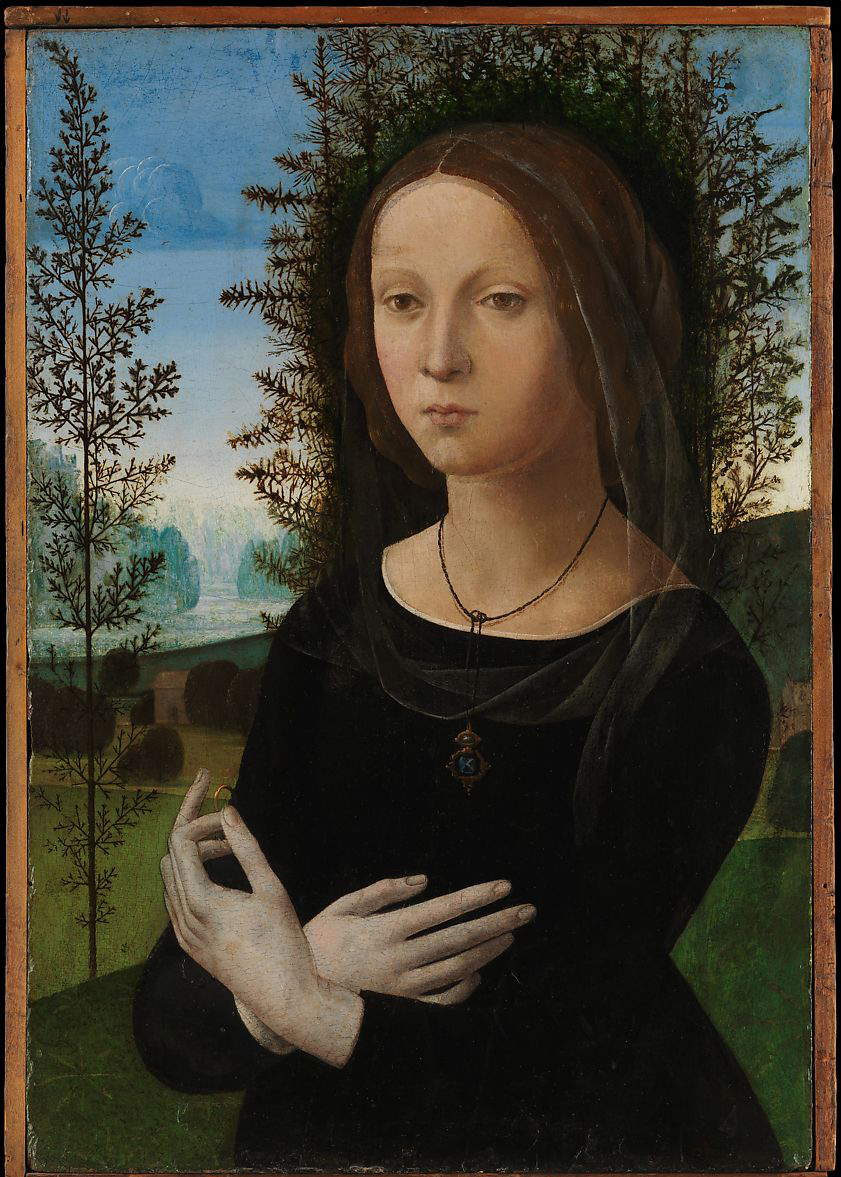 |
| Lorenzo di Credi, Portrait of a Woman in Black (Ginevra deBenci) (panel, 58.7 x 40 cm; New York, Metropolitan Museum) |
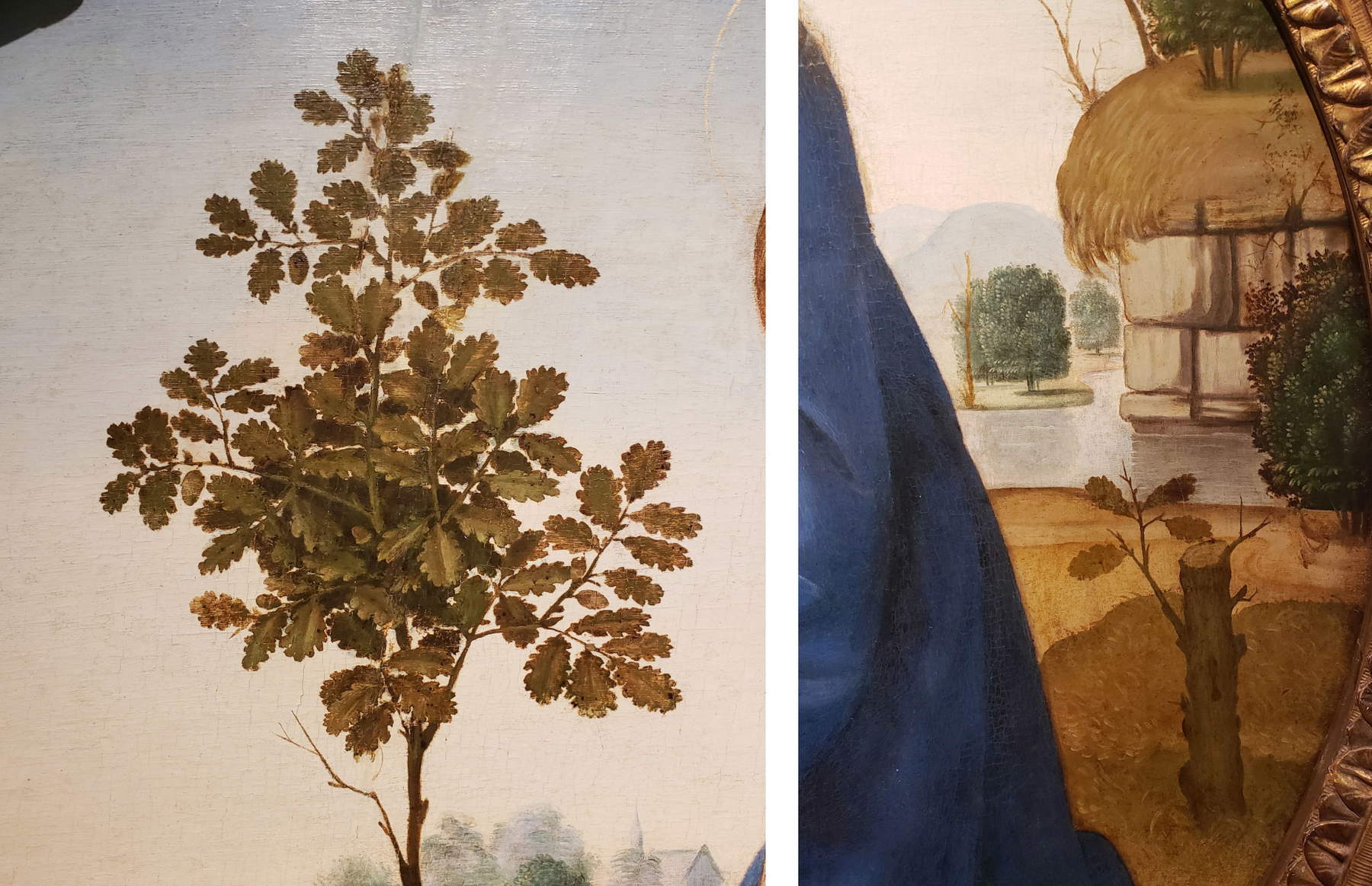 |
| Lorenzo di Credi, Adoration of the Child (Tondo Portinari), details |
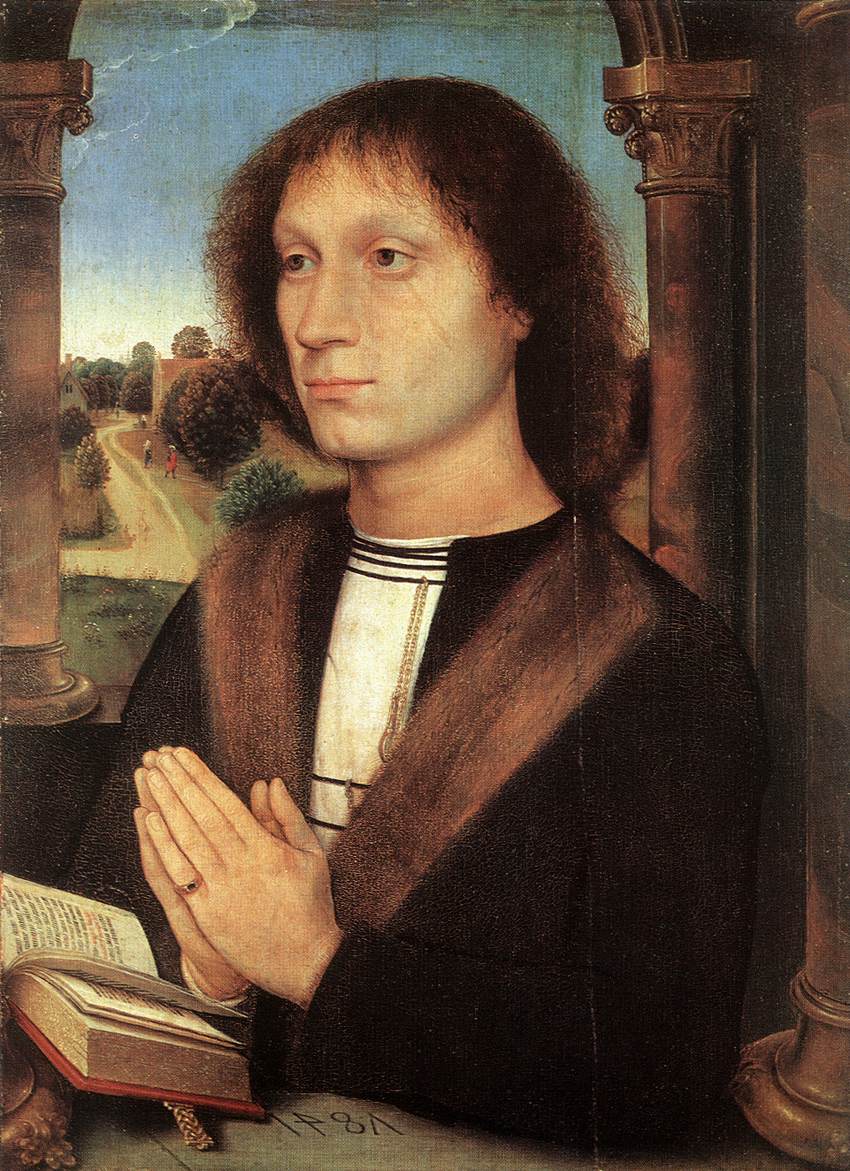 |
| Hans Memling, Portrait of Benedetto Portinari, right panel of the Portinari Triptych, recto (1487; oil on panel, 45 x 34 cm the third panel, 45.5 x 100 cm the triptych; Florence, Uffizi) |
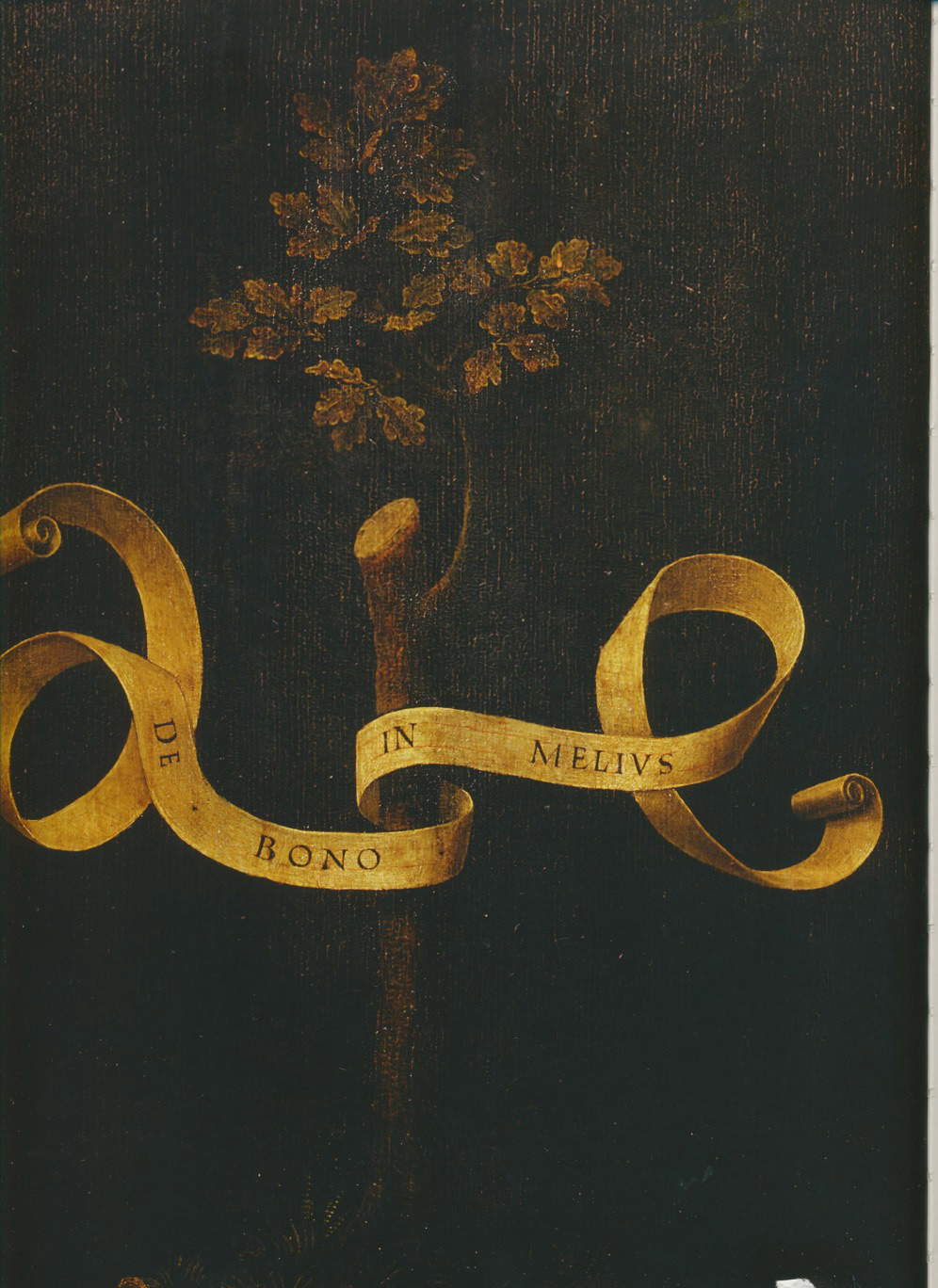 |
| Hans Memling, Portrait of Benedetto Portinari, verso |
And finally, one last consideration. The Benedetto Portinari triptych, although executed by Memling in Flanders, had to return to Florence soon, as in the early sixteenth century it was located at the Spedale di Santa Maria Nuova, an institution of great importance in the life of the city, founded in the late thirteenth century by a Portinari12. It is possible that the commission of the tondo to Lorenzo was motivated, in some respect, by a connection with Santa Maria Nuova: in fact, in 1486 he was staying as a tenant in a room belonging to the Spedale; and it was also at the Spedale that the over-seventy-year-old artist ’committed’ himself in 1531, renouncing his possessions in exchange for a modest annuity. There the painter would die five years later.
A complex of data that confirms the dating of the Portinari tondo to the late 1580s, when Benedetto, in his early twenties but already well established in the business world that was taking place along the Italy-France-Flanders circuit,13 probably stopped in Florence after leaving Milan and before moving to Bruges.
1 J.A.Crowe-G.B.Cavalcaselle, A History of Painting in Italy, London 1914, 6, p.41. Later the painting is cited by A.Humphreys, Credi, Tommaso and a York Tondo, “Preview,” 86, 22, p.788.
2 The tondo is executed on poplar boards and painted in tempera, with partial and circumscribed interventions in oil. A recent restuarion removed the opacities of the last pictorial layer and emended small color falls; some traces of surface wear remain on the left side.
3 G.Dalli Regoli, Lorenzo di Credi , Milan 1966, p.188; Eadem, Lorenzo di Credi e la pittura di devozione. Il tondo Casati, “Critica d’arte” 22, 2004, pp.75-88; Eadem, I ’maltreatati delle Vite vasariane. Reflections and marginal reparations, “Art Criticism,” 33-34, 2008, pp.9-33. To the latter texts I refer for an update of the relevant bibliography, which cannot find space here.
4 The large panel is in the Uffizi: see F.W.Kent, Lorenzo di Credi, his patron Jacopo BongianniandSavonarola, “The Burlington Magazine” , 125, 1983, pp.539-541.
5 G.Vasari, The Lives (1568),ed. edited by P.Barocchi and R.Bettarini,,, Florence 1966-1987, IV (text), pp.299-303.
6 Only in his most challenging work, which originated in the context of Andrea del Verrocchio’s lively workshop, the altarpiece preserved in Pistoia Cathedral, does Lorenzo adorn the crisp architecture by resorting to citrus and fir fronds, and the wild rose
7 I refer to the careful analysis of D.A.Brown, Leonardo da Vinci .Origins of a Genius, New Haven&London 1998, pp.101-121.
8 I recall that Leonardo, leaving for Milan in 1482, left Giovanni Benci theAdoration of the Magi and two books, probably very bulky and delicate, a ’mappamondo’ and a ’libro de’ diaspri’ (C.Vecce, La biblioteca perduta. I libri di Leonardo, Rome 2017, pp.72-73).
9 For the sake of brevity, I cite Florence and the Old Netherlands, 1430-1530, dialogues between artists, Catalogue of the exhibition (Florence 2008), edited by B.W.Meijer, Florence 2008, pp.28, 182-185; and the thorough discussion of F.Veratelli, I tratti del potere. Memling’s Italian clients, in Memling. Rinascimento fimmingo, Catalogue of the exhibition (Rome, 2014-2015) edited by Till-Holger Borchert, Milan 2014, pp.61-65, 218-219 (Till-Holger Borchert’s card); the recognition of the triptych and the link with the Portinari is, moreover, due to A.Warburg. The Rebirth of Ancient Paganism, [1966], ed. edited by M.Ghelardi, Turin 2004, pp.320-357.
10 The triptych consisted of the Madonna in the center (Berlin) and effigies of St.Benedict on the left, of Portinari on the right (Uffizi).
11 Veratelli 2014, cit., p.61.
12 Memling 2014, cit,,pp.218-219.
13 It is the same essay cited above that illustrates how the two Portinari brothers, Benedetto and Folco, were early active as bankers and entrepreneurs but also as patrons of works of art.
Warning: the translation into English of the original Italian article was created using automatic tools. We undertake to review all articles, but we do not guarantee the total absence of inaccuracies in the translation due to the program. You can find the original by clicking on the ITA button. If you find any mistake,please contact us.